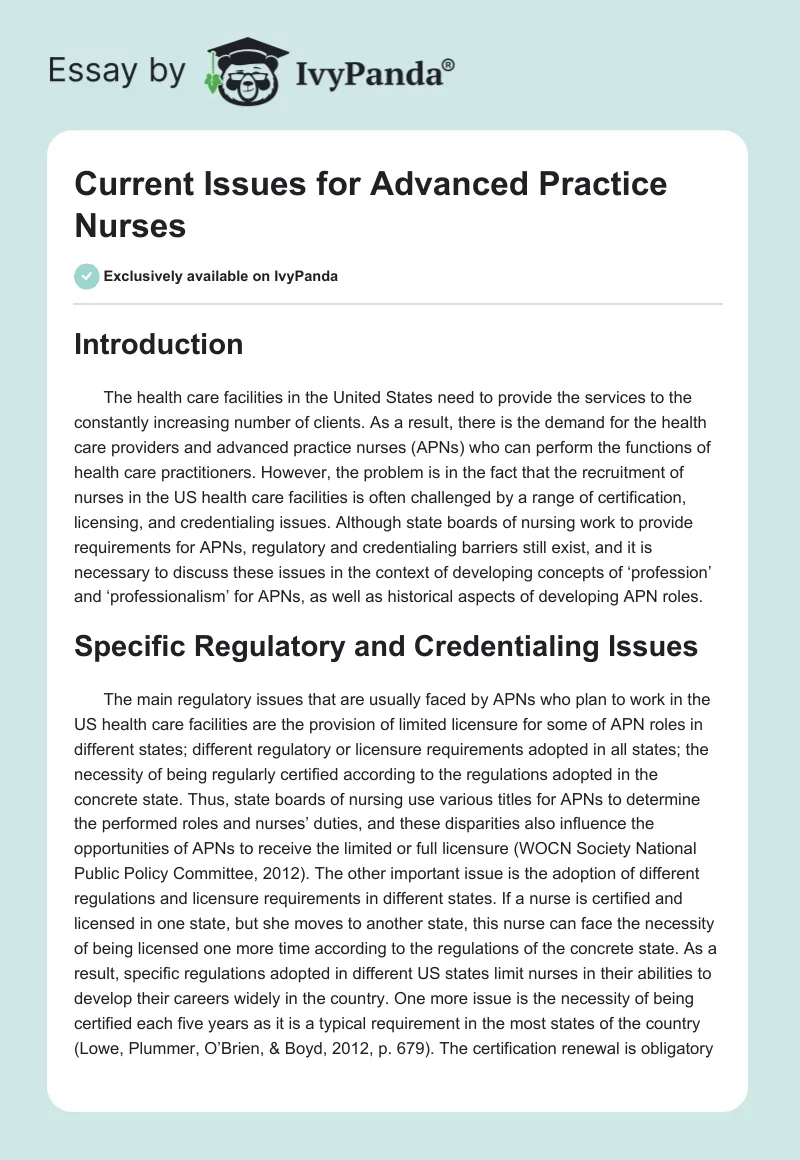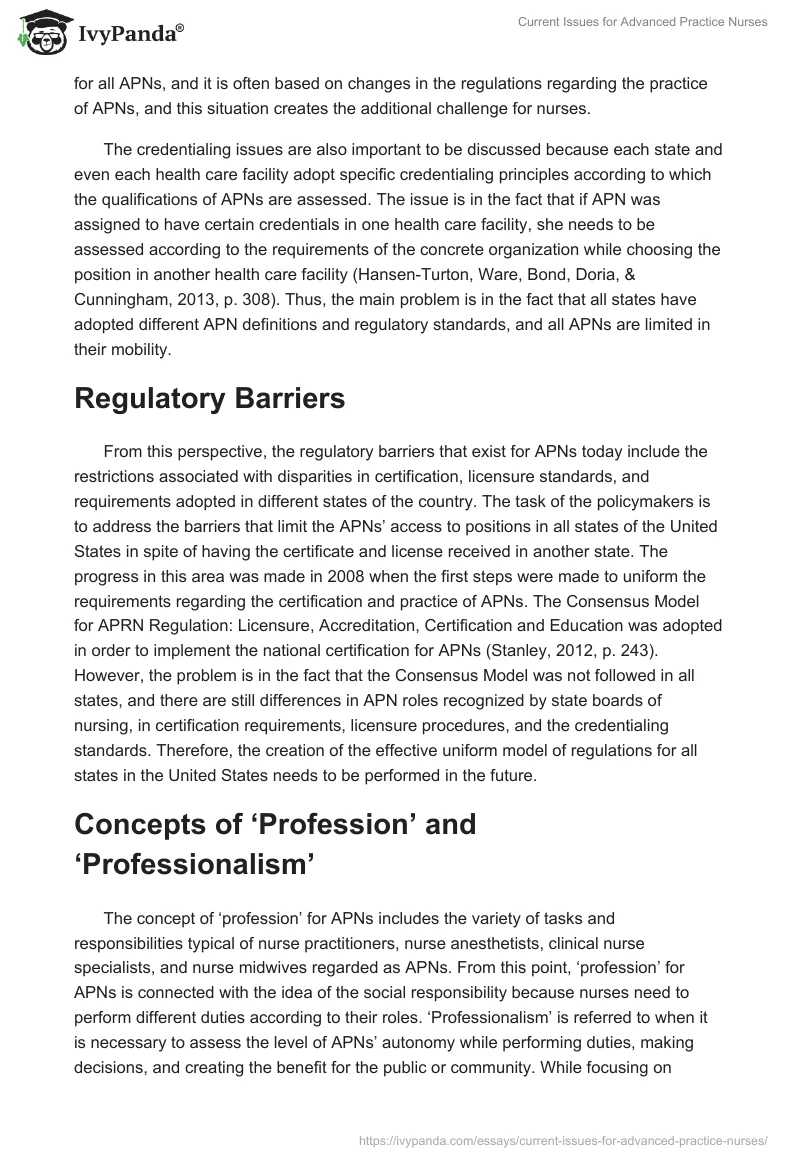Introduction
The health care facilities in the United States need to provide the services to the constantly increasing number of clients. As a result, there is the demand for the health care providers and advanced practice nurses (APNs) who can perform the functions of health care practitioners. However, the problem is in the fact that the recruitment of nurses in the US health care facilities is often challenged by a range of certification, licensing, and credentialing issues. Although state boards of nursing work to provide requirements for APNs, regulatory and credentialing barriers still exist, and it is necessary to discuss these issues in the context of developing concepts of ‘profession’ and ‘professionalism’ for APNs, as well as historical aspects of developing APN roles.
Specific Regulatory and Credentialing Issues
The main regulatory issues that are usually faced by APNs who plan to work in the US health care facilities are the provision of limited licensure for some of APN roles in different states; different regulatory or licensure requirements adopted in all states; the necessity of being regularly certified according to the regulations adopted in the concrete state. Thus, state boards of nursing use various titles for APNs to determine the performed roles and nurses’ duties, and these disparities also influence the opportunities of APNs to receive the limited or full licensure (WOCN Society National Public Policy Committee, 2012). The other important issue is the adoption of different regulations and licensure requirements in different states. If a nurse is certified and licensed in one state, but she moves to another state, this nurse can face the necessity of being licensed one more time according to the regulations of the concrete state. As a result, specific regulations adopted in different US states limit nurses in their abilities to develop their careers widely in the country. One more issue is the necessity of being certified each five years as it is a typical requirement in the most states of the country (Lowe, Plummer, O’Brien, & Boyd, 2012, p. 679). The certification renewal is obligatory for all APNs, and it is often based on changes in the regulations regarding the practice of APNs, and this situation creates the additional challenge for nurses.
The credentialing issues are also important to be discussed because each state and even each health care facility adopt specific credentialing principles according to which the qualifications of APNs are assessed. The issue is in the fact that if APN was assigned to have certain credentials in one health care facility, she needs to be assessed according to the requirements of the concrete organization while choosing the position in another health care facility (Hansen-Turton, Ware, Bond, Doria, & Cunningham, 2013, p. 308). Thus, the main problem is in the fact that all states have adopted different APN definitions and regulatory standards, and all APNs are limited in their mobility.
Regulatory Barriers
From this perspective, the regulatory barriers that exist for APNs today include the restrictions associated with disparities in certification, licensure standards, and requirements adopted in different states of the country. The task of the policymakers is to address the barriers that limit the APNs’ access to positions in all states of the United States in spite of having the certificate and license received in another state. The progress in this area was made in 2008 when the first steps were made to uniform the requirements regarding the certification and practice of APNs. The Consensus Model for APRN Regulation: Licensure, Accreditation, Certification and Education was adopted in order to implement the national certification for APNs (Stanley, 2012, p. 243). However, the problem is in the fact that the Consensus Model was not followed in all states, and there are still differences in APN roles recognized by state boards of nursing, in certification requirements, licensure procedures, and the credentialing standards. Therefore, the creation of the effective uniform model of regulations for all states in the United States needs to be performed in the future.
Concepts of ‘Profession’ and ‘Professionalism’
The concept of ‘profession’ for APNs includes the variety of tasks and responsibilities typical of nurse practitioners, nurse anesthetists, clinical nurse specialists, and nurse midwives regarded as APNs. From this point, ‘profession’ for APNs is connected with the idea of the social responsibility because nurses need to perform different duties according to their roles. ‘Professionalism’ is referred to when it is necessary to assess the level of APNs’ autonomy while performing duties, making decisions, and creating the benefit for the public or community. While focusing on finding differences in discussing the concepts of ‘profession’ and ‘professionalism’ in relation to registered nurses (RNs) and APNs, it is important to state that APNs include registered nurses, and in most cases, the roles of advanced practice registered nurses (APRNs) are discussed (Hansen-Turton et al., 2013). However, for RNs, the concept of ‘profession’ is associated with certain duties determined by licensing bodies. ‘Professionalism’ is associated with performing these duties according to the high-level standards that are set by the nursing professional council in the concrete state. Therefore, these concepts are wider when they are formulated for APNs.
Historical Development of APN Roles
The main historical factors that influenced the development of APN roles are connected with the constantly increasing need for more nurse specialists performing a variety of tasks that were previously typical of only physicians. In the 19th century, the first nurse anesthetists appeared to assist in hospitals because of the shortage of the professional workforce. In the 1920s, more attention became paid to the health of the population in the rural territories, and the first nurse midwives provided the assistance in the remote districts of the country. In the 1960s, more clinical nurse specialists graduated in the United States, and this situation was influenced by the demand for the professional workforce in the acute care clinical settings. That was the period when the first nurse practitioners appeared as specialists in providing certain medical procedures and analyses, as well as the evaluation of the situation. Nurses become educated to make decisions regarding diagnoses and treatments (Lowe et al., 2012). As a result, APNs can perform as autonomous professionals who are usually responsible for assessing a patient, diagnosing, providing the primary care, and planning the treatment. During a century, the roles of APNs developed significantly, and these nurses can provide the high-quality care to a number of patients today without referring to the assistance of physicians.
Conclusion
Nowadays, there is no uniform approach followed in the United States in order to provide the certification, licensure, and credentialing for APNs in the country. As a consequence, many nurses are limited in their possibilities to move in other states and be assessed as having appropriate qualifications. In spite of the fact that the advanced practice nursing concept has the deep historical roots, there are still barriers associated with the practice of APNs that needs to be addressed in order to provide nurses with the opportunities to increase their professionalism.
References
Hansen-Turton, T., Ware, J., Bond, L., Doria, N., & Cunningham, P. (2013). Are managed care organizations in the United States impeding the delivery of primary care by nurse practitioners? A 2012 update on managed care organization credentialing and reimbursement practices. Population Health Management, 16(5), 306-309.
Lowe, G., Plummer, V., O’Brien, A. P., & Boyd, L. (2012). Time to clarify–the value of advanced practice nursing roles in health care. Journal of Advanced Nursing, 68(3), 677-685.
Stanley, J. M. (2012). Impact of new regulatory standards on advanced practice registered nursing: The APRN Consensus Model and LACE. Nursing Clinics of North America, 47(2), 241-250.
WOCN Society National Public Policy Committee. (2012). Reimbursement of advanced practice registered nurse services: A fact sheet. Journal of Wound, Ostomy, and Continence Nursing, 39(2), 7-16.


